Metasurface of Combined Semicircular Rings with Orthogonal Slit Pairs for Generation of Dual Vector Beams
Abstract
:1. Introduction
2. Materials and Methods
2.1. The Unit of the Orthogonal Slit Pair and the Transmitted Light Field
2.2. The Output Light Field of the Slit Pairs on a Circular Ring under Circular Polarization Illumination
2.3. The Vector Beams Produced by Slit Pairs on an Circular Ring under Illumination of Linear Polarized Light
2.4. The Dual Shifted Spots and Vector Beams Produced by Slit Pairs Arranged on the Combined Semicircular Rings
3. Results
3.1. The FDTD Results for Metasurface of A Single Group of Combined Semicircular Rings
3.2. Metasurfaces of Multiple Groups of Semicircular Rings and the FDTD Results for Different Dual Vector Beam
3.3. The FDTD Results for the Generated Dual Vector Beams of Different Orders and Polarization States
4. Discussion
5. Conclusions
Author Contributions
Funding
Data Availability Statement
Conflicts of Interest
References
- Zhan, Q.W. Cylindrical vector beams: From mathematical concepts to applications. Adv. Opt. Photon. 2009, 1, 1–57. [Google Scholar] [CrossRef]
- Wang, X.L.; Chen, J.; Li, Y.N.; Ding, J.P.; Guo, C.S.; Wang, H.T. Optical orbital angular momentum from the curl of polarization. Phys. Rev. Lett. 2010, 105, 253602. [Google Scholar] [CrossRef] [PubMed]
- Milione, G.; Sztul, H.I.; Nolan, D.A.; Alfano, R.R. Higher-Order Poincaré Sphere, Stokes Parameters, and the Angular Momentum of Light. Phys. Rev. Lett. 2011, 107, 053601. [Google Scholar] [CrossRef]
- Yi, X.N.; Liu, Y.C.; Ling, X.H.; Zhou, X.X.; Ke, Y.G.; Luo, H.L.; Wen, S.C.; Fan, D.Y. Hybrid-order Poincare sphere. Phys. Rev. A 2015, 91, 023801. [Google Scholar] [CrossRef] [Green Version]
- Ren, Z.C.; Kong, L.J.; Li, S.M.; Qian, S.X.; Li, Y.N.; Tu, C.H.; Wang, H.T. Generalized Poincaré sphere. Opt. Express 2015, 23, 26586. [Google Scholar] [CrossRef] [PubMed]
- Liu, Y.C.; Ling, X.H.; Yi, X.N.; Zhou, X.X.; Luo, H.L.; Wen, S.C. Realization of polarization evolution on higher-order Poincaré sphere with metasurface. Appl. Phys. Lett. 2014, 104, 191110. [Google Scholar] [CrossRef] [Green Version]
- Chen, P.; Ge, S.J.; Duan, W.; Wei, B.Y.; Cui, G.X.; Hu, W.; Lu, Y.Q. Digitalized geometric phases for parallel optical spin and orbital angular momentum encoding. ACS Photon. 2017, 4, 1333–1338. [Google Scholar] [CrossRef]
- Chen, S.Z.; Zhou, X.X.; Liu, Y.C.; Ling, X.H.; Luo, H.L.; Wen, S.C. Generation of arbitrary cylindrical vector beams on the higher order Poincaré sphere. Opt. Lett. 2014, 39, 5274–5276. [Google Scholar] [CrossRef] [Green Version]
- Naidoo, D.; Roux, F.S.; Dudley, A.; Litvin, I.; Piccirillo, B.; Marucci, L.; Forbes, A. Controlled generation of higher-order Poincaré sphere beams from a laser. Nat. Photon. 2016, 10, 327–332. [Google Scholar] [CrossRef] [Green Version]
- Chen, C.; Zhang, Y.; Ma, L.; Zhang, Y.; Li, Z.; Zhang, R.; Zeng, X.; Zhan, Z.; He, C.; Ren, X.; et al. Flexible generation of higher-order Poincaré beams with high efficiency by manipulating the two eigenstates of polarized optical vortices. Opt. Express 2020, 28, 10618–10632. [Google Scholar] [CrossRef] [PubMed]
- Huang, L.; Guo, H.L.; Li, J.F.; Ling, L.; Feng, B.H.; Li, Z.Y. Optical trapping of gold nanoparticles by cylindrical vector beam. Opt. Lett. 2018, 37, 1694–1696. [Google Scholar] [CrossRef] [PubMed]
- Nivas, J.; He, S.; Rubano, A.; Vecchione, A.; Paparo, D.; Marrucci, L.; Bruzzese, R.; Amoruso, S. Direct femtosecond laser surface structuring with optical vortex beams generated by a q-plate. Sci. Rep. 2015, 5, 17929. [Google Scholar] [CrossRef] [Green Version]
- Xie, X.S.; Chen, Y.Z.; Yang, K.; Zhou, J.Y. Harnessing the Point-Spread Function for High-Resolution Far-Field Optical Microscopy. Phys. Rev. Lett. 2014, 113, 263901. [Google Scholar] [CrossRef]
- Rumand, A.; Cardano, F.; Piccirillo, B.; Marrucci, L. Q-plate technology: A progress review. J. Opt. Soc. Am. B 2019, 36, 70–87. [Google Scholar]
- Sit, A.; Bouchard, F.; Fickler, R.; Gagnon-Bischoff, J.; Larocque, H.; Heshami, K.; Elser, D.; Peuntinger, C.; Günthner, K.; Heim, B.; et al. High-dimensional intracity quantum cryptography with structured photons. Optica 2017, 4, 1006–1010. [Google Scholar] [CrossRef] [Green Version]
- Cardano, F.; Massa, F.; Qassim, H.; Karimi, E.; Slussarenko, S.; Paparo, D.; Lisio, C.D.; Sciarrino, F.; Santamato, E.; Boyd, R.W.; et al. Quantum walks and wavepacket dynamics on a lattice with twisted photons. Sci. Adv. 2015, 1, e1500087. [Google Scholar] [CrossRef] [PubMed] [Green Version]
- Gorkunov, M.V.; Kasyanova, I.V.; Artemov, V.V.; Ezhov, A.A.; Mamonova, A.V.; Simdyankin, I.V.; Palto, S.P. Superperiodic Liquid-Crystal Metasurfaces for Electrically Controlled Anomalous Refraction. ACS Photon. 2020, 7, 3096–3105. [Google Scholar] [CrossRef]
- Rocco, D.; Carletti, L.; Caputo, R.; Finazzi, M.; Celebrano, M.; De Angelis, C. Switching the second harmonic generation by a dielectric metasurface via tunable liquid crystal. Opt. Express 2020, 28, 12037–12046. [Google Scholar] [CrossRef]
- Kowerdziej, R.; Wróbel, J.; Kula, P. Ultrafast electrical switching of nanostructured metadevice with dual-frequency liquid crystal. Sci. Rep. 2019, 9, 1–8. [Google Scholar] [CrossRef] [PubMed] [Green Version]
- Buchnev, O.; Podoliak, N.; Kaltenecker, K.; Walther, M.; Fedotov, V.A. Metasurface-based optical liquid crystal cell as an ultrathin spatial phase modulator for THz applications. ACS Photon. 2020, 7, 3199–3206. [Google Scholar] [CrossRef]
- Wang, F.; Xiao, M.; Sun, K.; Wei, Q.H. Generation of radially and azimuthally polarized light by optical transmission through concentric circular nanoslits in Ag films. Opt. Express 2010, 18, 63–71. [Google Scholar] [CrossRef] [PubMed]
- Zhao, Z.; Wang, J.; Li, S.H.; Willner, A.E. Metamaterials-based broadband generation of orbital angular momentum carrying vector beams. Opt. Lett. 2013, 38, 932–934. [Google Scholar] [CrossRef] [PubMed]
- Wang, S.Y.; Abeysinghe, D.C.; Zhan, Q.W. Generation of vectorial optical fields with slot-antenna-based metasurface. Opt. Lett. 2015, 40, 4711–4714. [Google Scholar] [CrossRef] [PubMed]
- Yu, P.; Chen, S.Q.; Li, J.X.; Cheng, H.; Li, Z.C.; Liu, W.W.; Xie, B.Y.; Liu, Z.C.; Tian, J.G. Generation of vector beams with arbitrary spatial variation of phase and linear polarization using plasmonic metasurfaces. Opt. Lett. 2015, 40, 3229–3232. [Google Scholar] [CrossRef] [PubMed]
- Guo, Q.H.; Schlickriede, C.; Wang, D.Y.; Liu, H.C.; Xiang, Y.J.; Zentgraf, T.; Zhang, S. Manipulation of vector beam polarization with geometric metasurfaces. Opt. Express 2017, 25, 14300–14307. [Google Scholar] [CrossRef] [Green Version]
- Devlin, R.C.; Ambrosio, A.; Rubin, N.A.; Mueller, J.P.B.; Capasso, F. Arbitrary spin-to–orbital angular momentum conversion of light. Science 2017, 358, 896–900. [Google Scholar] [CrossRef] [Green Version]
- Bao, Y.J.; Ni, J.C.; Qiu, C.W. A Minimalist Single-Layer Metasurface for Arbitrary and Full Control of Vector Vortex Beams. Adv. Mater. 2020, 32, 1905659. [Google Scholar] [CrossRef]
- Li, T.; Li, X.; Yan, S.; Xu, X.; Wang, S.; Yao, B.; Wang, Z.; Zhu, S. Generation and Conversion Dynamics of Dual Bessel Beams with a Photonic Spin-Dependent Dielectric Metasurface. Phys. Rev. A 2021, 15, 014059. [Google Scholar] [CrossRef]
- Zhang, Y.; Yang, X.; Gao, J. Generation of Nondiffracting Vector Beams with Ring-Shaped Plasmonic Metasurfaces. Phys. Rev. A 2019, 11, 064059. [Google Scholar] [CrossRef]
- Heiden, J.; Ding, F.; Linnet, J. Gap-Surface Plasmon Metasurfaces for Broadband Circular-to-Linear Polarization Conversion and Vector Vortex Beam Generation. Adv. Opt. Mater. 2019, 7, 1801414. [Google Scholar] [CrossRef]
- Yue, F.Y.; Wen, D.D.; Zhang, C.M.; Gerardot, B.D.; Wang, W.; Zhang, S.; Chen, X.Z. Multichannel Polarization-Controllable Superpositions of Orbital Angular Momentum States. Adv. Mater. 2017, 29, 1603838. [Google Scholar] [CrossRef]
- Wang, E.L.; Shi, L.N.; Niu, J.B.; Hua, Y.L.; Li, H.L.; Zhu, X.L.; Xie, C.Q.; Ye, T.C. Multichannel Spatially Nonhomogeneous Focused Vector Vortex Beams for Quantum Experiments. Adv. Opt. Mater. 2019, 7, 1801415. [Google Scholar] [CrossRef]
- Ding, F.; Chen, Y.; Yang, Y.; Bozhevolnyi, S.I. Multifunctional metamirrors for broadband focused vector-beam generation. Adv. Opt. Mater. 2019, 7, 1900724. [Google Scholar] [CrossRef]
- Jiang, Z.H.; Kang, L.; Yue, T.; Xu, H.X.; Yang, Y.; Jin, Z.; Yu, C.; Hong, W.; Werner, D.H.; Qiu, C.W. A Single Noninterleaved Metasurface for High-Capacity and Flexible Mode Multiplexing of Higher-Order Poincaré Sphere Beams. Adv. Mater. 2020, 32, 1903983. [Google Scholar] [CrossRef]
- Chen, L.; Ma, Q.; Nie, Q.F.; Hong, Q.R.; Cui, H.Y.; Ruan, Y.; Cui, T.J. Dual-polarization programmable metasurface modulator for near-field information encoding and transmission. Photon. Res. 2021, 9, 116–124. [Google Scholar] [CrossRef]
- Li, L.L.; Cui, T.J.; Wei, J.W.; Liu, S.; Ding, J.; Xiang, W.X.; Li, Y.B.; Jiang, M.H.; Qiu, C.W.; Zhang, S. Electromagnetic reprogrammable coding metasurface holograms. Nat. Commun. 2017, 8, 1–7. [Google Scholar] [CrossRef] [Green Version]
- Xu, H.X.; Han, L.; Li, Y.; Sun, Y.M.; Zhao, J.L.; Zhang, S.; Qiu, C.W. Completely Spin-Decoupled Dual-Phase Hybrid Metasurfaces for Arbitrary Wavefront Control. ACS Photon. 2019, 6, 211–220. [Google Scholar] [CrossRef]
- Teperik, T.V.; Archambault, A.; Marquier, F.; Greffe, J.J. Huygens-Fresnel principle for surface plasmons. Opt. Express 2009, 17, 17483–17490. [Google Scholar] [CrossRef] [Green Version]
- Sang, B.H.; Ke, Y.G.; Wua, J.; Luo, H.L.; Shu, W.X.; Wen, S.C. Generation of pure Laguerre-Gaussian vector beams on the higher-order Poincaré sphere by hollow Gaussian beams through dielectric metasurfaces. Opt. Commun. 2019, 439, 27–33. [Google Scholar] [CrossRef]
- Zeng, X.Y.; Zhang, Y.Q.; Zhang, R.R.; Ren, X.R.; Zhan, Z.J.; Gu, M.N.; Sun, R.; Liu, C.X.; Cheng, C.F. Generation of vector beams of Bell-like states by manipulating vector vortex modes with plasmonic metasurfaces. Opt. Lett. 2021, 46, 528–531. [Google Scholar] [CrossRef]

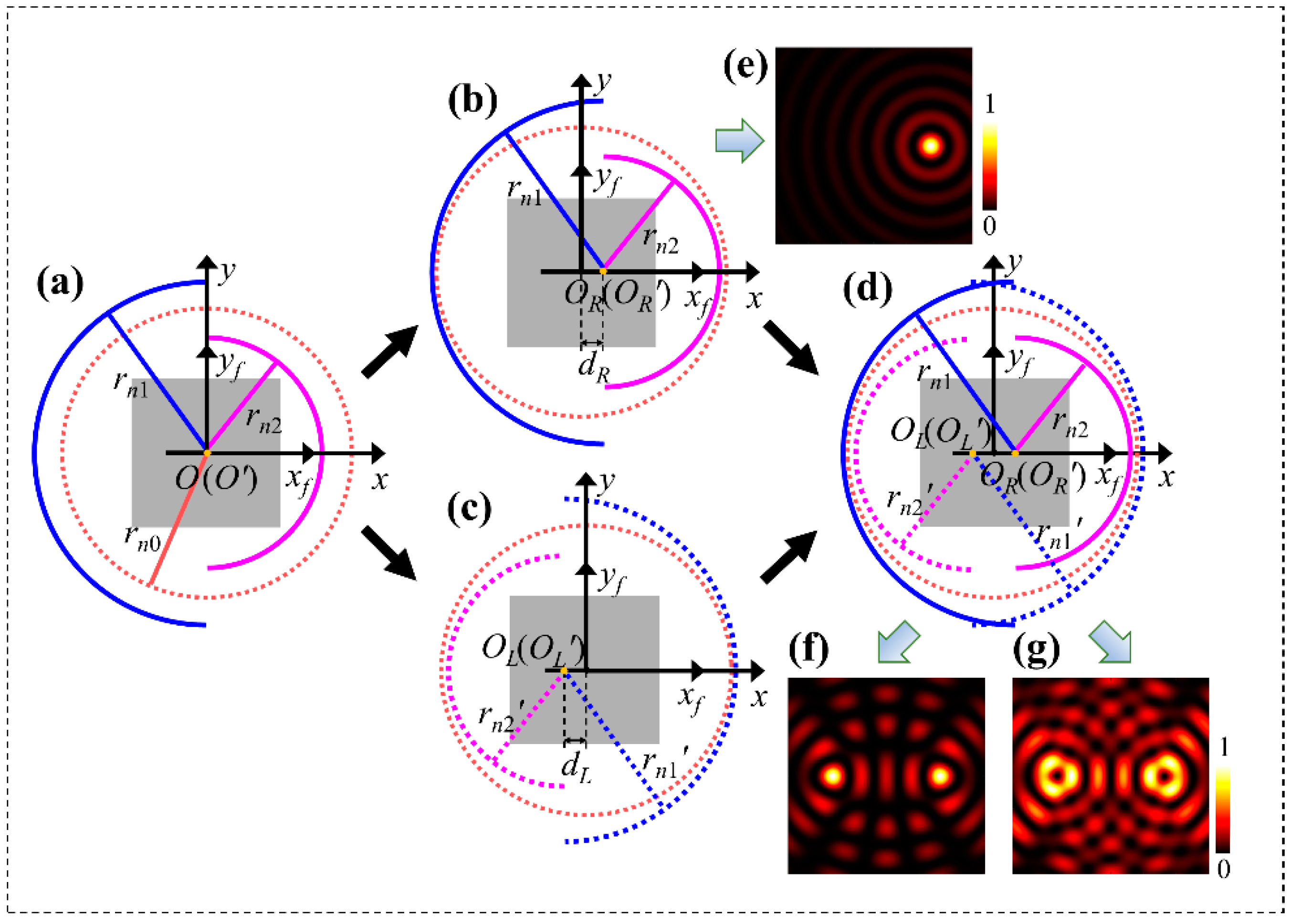
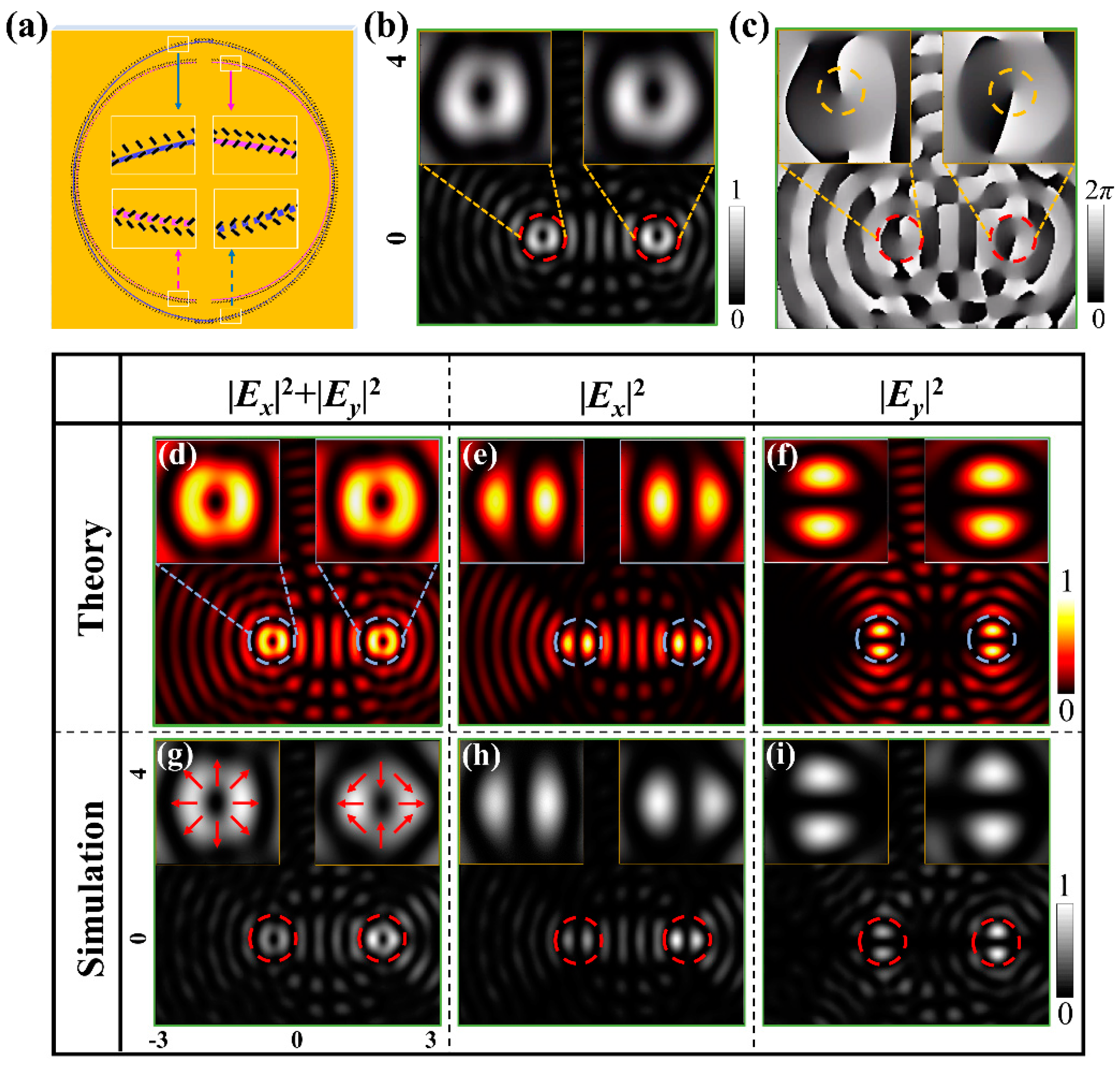
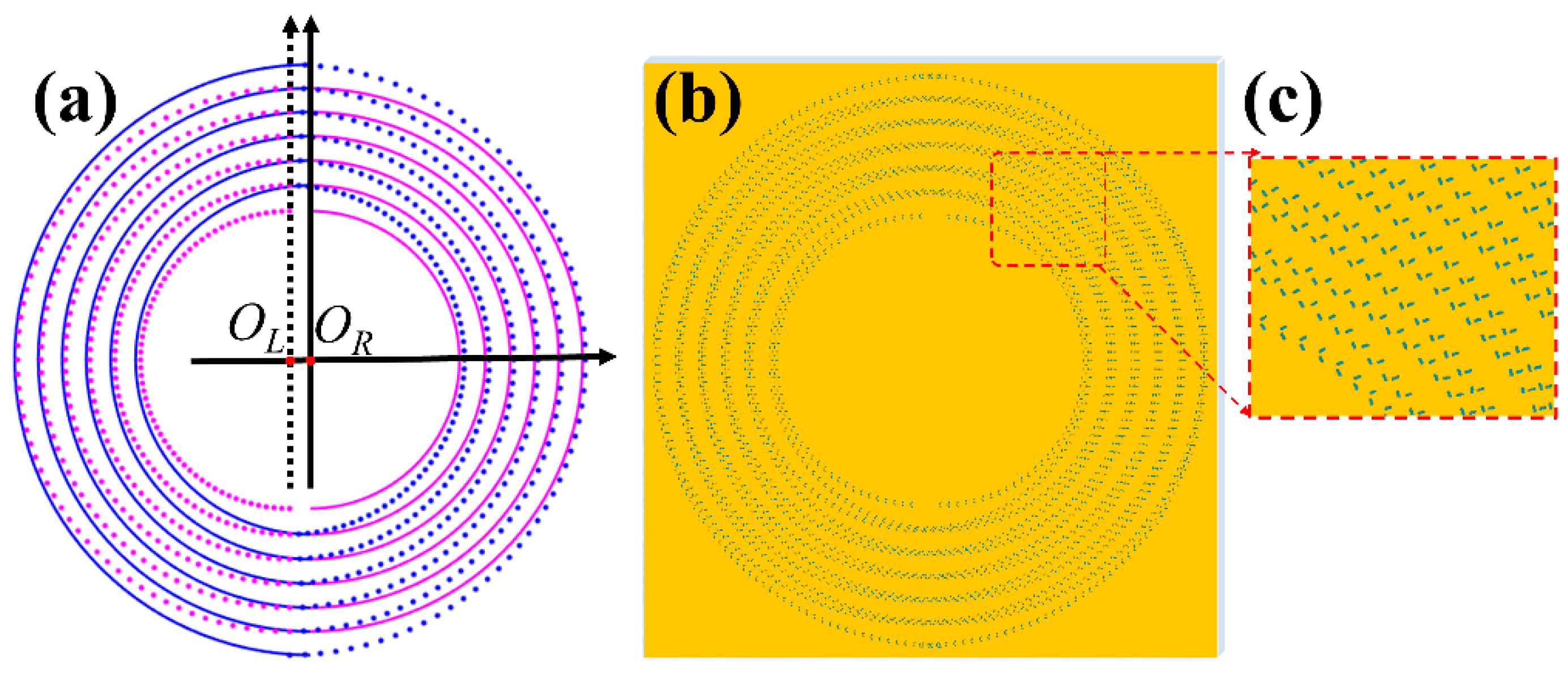
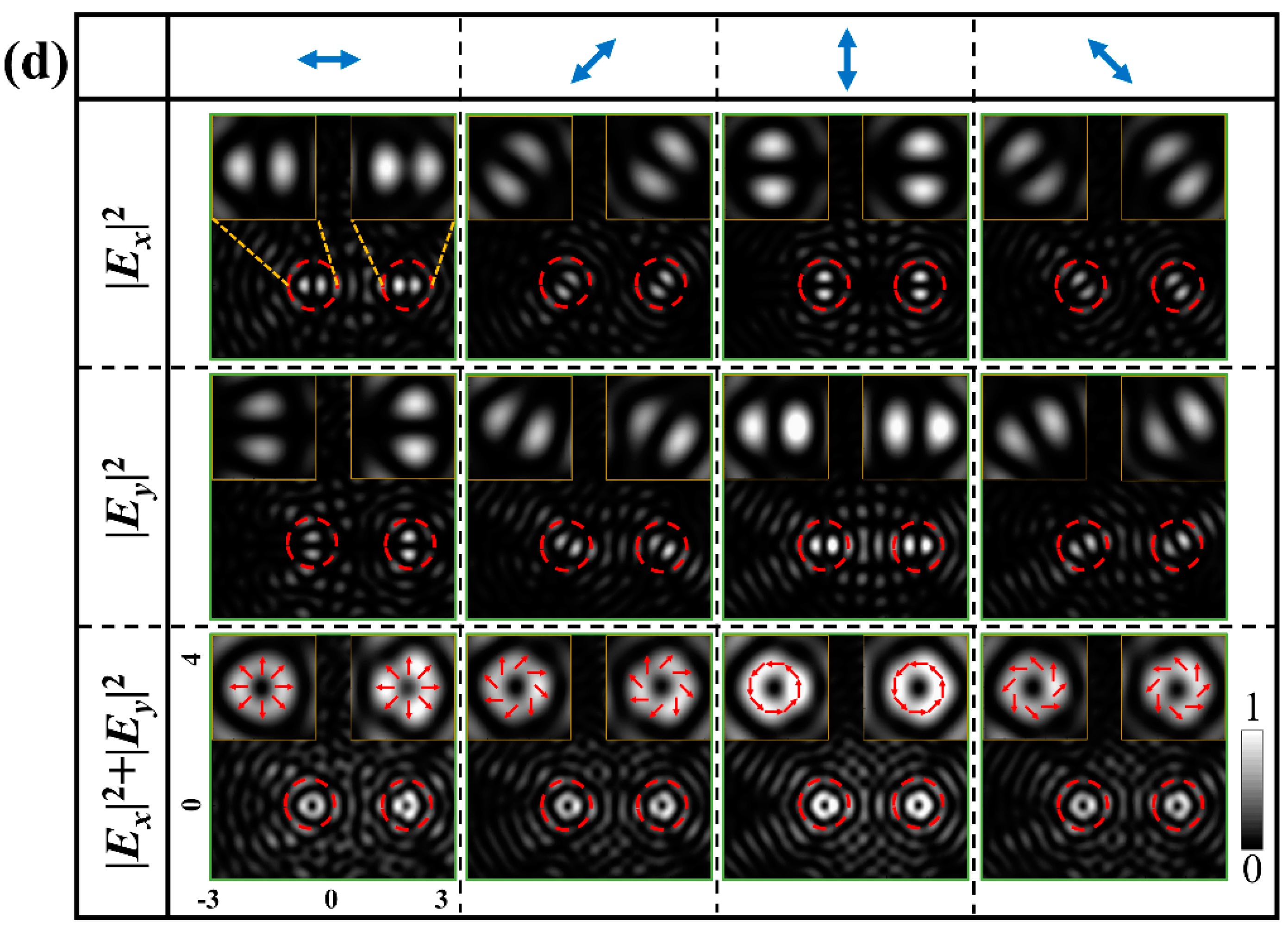

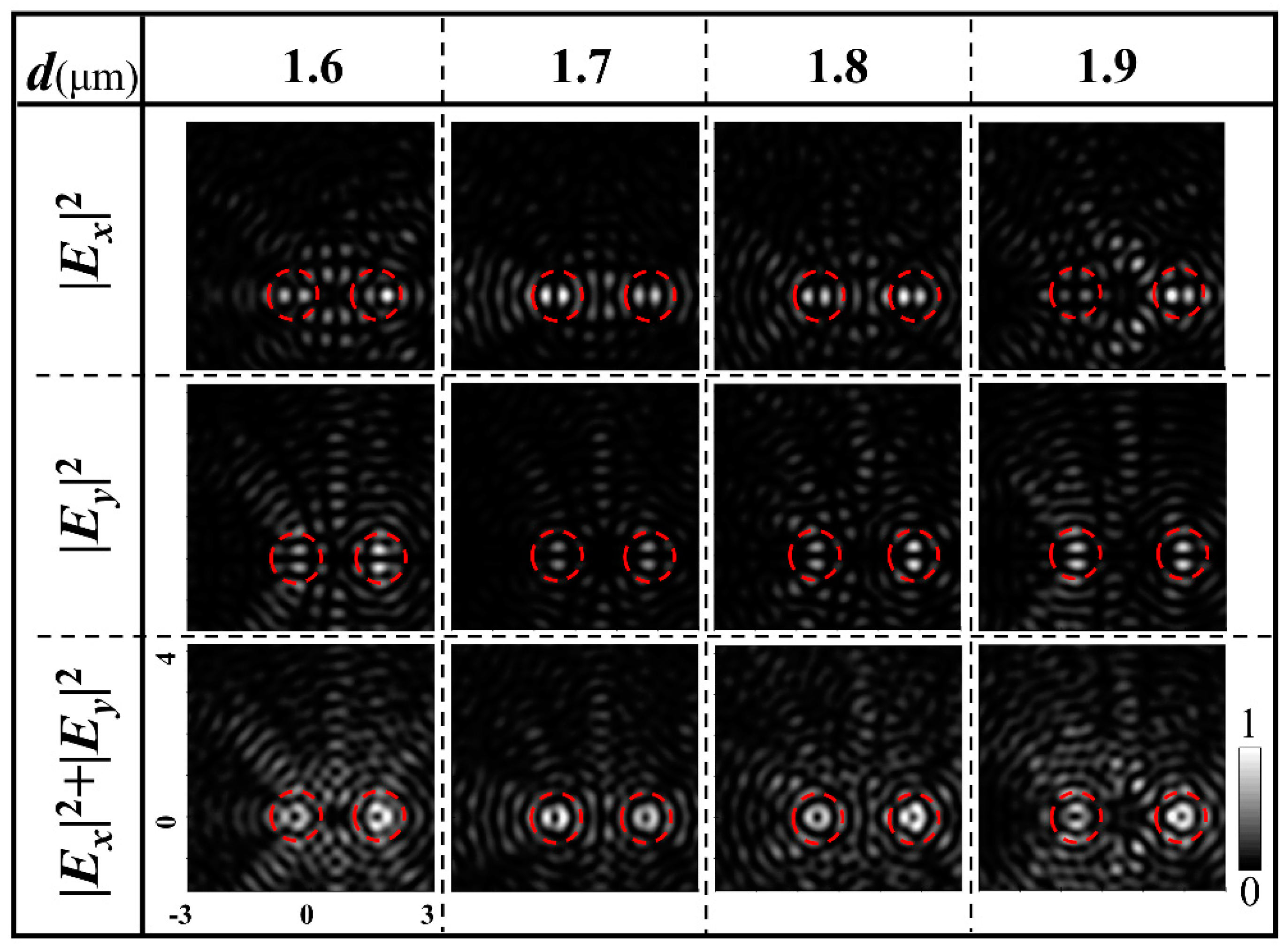
| Group of Semicircular Rings | 1 | 2 | 3 | 4 | 5 | 6 | |
|---|---|---|---|---|---|---|---|
| Solid blue line, OR | n2 | 19 | 23 | 27 | 31 | 35 | 39 |
| Solid red line, OR | n1 | 15 | 19 | 23 | 27 | 31 | 35 |
| Dotted blue line, OL | n2’ | 19 | 23 | 27 | 31 | 35 | 39 |
| Dotted bed line, OL | n1’ | 15 | 19 | 23 | 27 | 31 | 35 |
| rn1 (μm) | 19.62 | 22.43 | 25.17 | 27.88 | 30.55 | 33.21 | |
| rn2 (μm) | 16.73 | 19.62 | 22.43 | 25.17 | 27.88 | 30.55 | |
Publisher’s Note: MDPI stays neutral with regard to jurisdictional claims in published maps and institutional affiliations. |
© 2021 by the authors. Licensee MDPI, Basel, Switzerland. This article is an open access article distributed under the terms and conditions of the Creative Commons Attribution (CC BY) license (https://creativecommons.org/licenses/by/4.0/).
Share and Cite
Kong, Q.; Gu, M.; Zeng, X.; Sun, R.; Zhang, Y.; Liu, C.; Ma, H.; Gui, W.; Cheng, C. Metasurface of Combined Semicircular Rings with Orthogonal Slit Pairs for Generation of Dual Vector Beams. Nanomaterials 2021, 11, 1718. https://doi.org/10.3390/nano11071718
Kong Q, Gu M, Zeng X, Sun R, Zhang Y, Liu C, Ma H, Gui W, Cheng C. Metasurface of Combined Semicircular Rings with Orthogonal Slit Pairs for Generation of Dual Vector Beams. Nanomaterials. 2021; 11(7):1718. https://doi.org/10.3390/nano11071718
Chicago/Turabian StyleKong, Qian, Manna Gu, Xiangyu Zeng, Rui Sun, Yuqin Zhang, Chunxiang Liu, Hong Ma, Weiling Gui, and Chuanfu Cheng. 2021. "Metasurface of Combined Semicircular Rings with Orthogonal Slit Pairs for Generation of Dual Vector Beams" Nanomaterials 11, no. 7: 1718. https://doi.org/10.3390/nano11071718
APA StyleKong, Q., Gu, M., Zeng, X., Sun, R., Zhang, Y., Liu, C., Ma, H., Gui, W., & Cheng, C. (2021). Metasurface of Combined Semicircular Rings with Orthogonal Slit Pairs for Generation of Dual Vector Beams. Nanomaterials, 11(7), 1718. https://doi.org/10.3390/nano11071718





